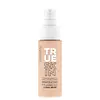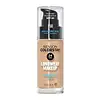Catrice True Skin Hydrating Foundation Versus Revlon ColorStay Foundation For Normal/Dry Skin SPF 20
What's inside
What's inside
 Key Ingredients
Key Ingredients

 Benefits
Benefits

 Concerns
Concerns

 Ingredients Side-by-side
Ingredients Side-by-side

Water
Skin ConditioningIsododecane
EmollientTalc
AbrasiveCoco-Caprylate
EmollientHydrogenated Tetradecenyl/Methylpentadecene
SolventTrimethylsiloxysilicate
EmollientCetyl PEG/PPG-10/1 Dimethicone
EmulsifyingPropanediol
SolventDimethicone
EmollientSodium Chloride
MaskingPEG-10 Dimethicone
Skin ConditioningSodium Hyaluronate
HumectantCitrullus Lanatus Seed Oil
EmollientTocopherol
AntioxidantDisteardimonium Hectorite
StabilisingCaprylyl Glycol
EmollientTriethoxycaprylylsilane
Dimethiconol Stearate
EmollientHexylene Glycol
EmulsifyingAluminum Hydroxide
EmollientPotassium Sorbate
PreservativeSodium Dehydroacetate
PreservativePhenoxyethanol
PreservativeParfum
MaskingCI 77491
Cosmetic ColorantCI 77492
Cosmetic ColorantCI 77499
Cosmetic ColorantCI 77891
Cosmetic ColorantWater, Isododecane, Talc, Coco-Caprylate, Hydrogenated Tetradecenyl/Methylpentadecene, Trimethylsiloxysilicate, Cetyl PEG/PPG-10/1 Dimethicone, Propanediol, Dimethicone, Sodium Chloride, PEG-10 Dimethicone, Sodium Hyaluronate, Citrullus Lanatus Seed Oil, Tocopherol, Disteardimonium Hectorite, Caprylyl Glycol, Triethoxycaprylylsilane, Dimethiconol Stearate, Hexylene Glycol, Aluminum Hydroxide, Potassium Sorbate, Sodium Dehydroacetate, Phenoxyethanol, Parfum, CI 77491, CI 77492, CI 77499, CI 77891
Cyclopentasiloxane
EmollientWater
Skin ConditioningDimethicone
EmollientTrimethylsiloxysilicate
EmollientPEG-9 Polydimethylsiloxyethyl Dimethicone
EmulsifyingPhenyl Trimethicone
Skin ConditioningMethyl Methacrylate Crosspolymer
Silica
AbrasiveButylene Glycol
HumectantNylon-12
Dimethicone/PEG-10/15 Crosspolymer
Alumina
AbrasiveDisteardimonium Hectorite
StabilisingEthylene Brassylate
MaskingHydrogen Dimethicone
Hydrolyzed Vegetable Protein
Skin ConditioningLaureth-7
EmulsifyingMagnesium Sulfate
Methicone
EmollientMica
Cosmetic ColorantPolyglyceryl-3 Diisostearate
EmulsifyingSalicylic Acid
MaskingSodium Hyaluronate
HumectantTetrasodium EDTA
Tocopheryl Acetate
AntioxidantTribehenin
EmollientTriethoxycaprylylsilane
Triethyl Citrate
MaskingEthylparaben
PreservativeMethylparaben
PreservativePhenoxyethanol
PreservativeCI 77491
Cosmetic ColorantCI 77492
Cosmetic ColorantCI 77499
Cosmetic ColorantCI 77891
Cosmetic ColorantTitanium Dioxide 4.3%
Cosmetic ColorantZinc Oxide 2.1%
Cosmetic ColorantCyclopentasiloxane, Water, Dimethicone, Trimethylsiloxysilicate, PEG-9 Polydimethylsiloxyethyl Dimethicone, Phenyl Trimethicone, Methyl Methacrylate Crosspolymer, Silica, Butylene Glycol, Nylon-12, Dimethicone/PEG-10/15 Crosspolymer, Alumina, Disteardimonium Hectorite, Ethylene Brassylate, Hydrogen Dimethicone, Hydrolyzed Vegetable Protein, Laureth-7, Magnesium Sulfate, Methicone, Mica, Polyglyceryl-3 Diisostearate, Salicylic Acid, Sodium Hyaluronate, Tetrasodium EDTA, Tocopheryl Acetate, Tribehenin, Triethoxycaprylylsilane, Triethyl Citrate, Ethylparaben, Methylparaben, Phenoxyethanol, CI 77491, CI 77492, CI 77499, CI 77891, Titanium Dioxide 4.3%, Zinc Oxide 2.1%
Ingredients Explained
These ingredients are found in both products.
Ingredients higher up in an ingredient list are typically present in a larger amount.
Ci 77491 is also hydrated iron III oxide. It's sole purpose is to give a red/pink hue to products.
Iron III oxides are classified as inorganic chemicals for coloring.
Synthetically created Ci 77491 is considered safer than those naturally found. This is because the synthetically created version may contain less impurities. Iron oxides are generally non-toxic and non-allergenic.
Learn more about CI 77491Ci 77492 is also hydrated iron III oxide. It's sole purpose is to give a yellow hue to products.
Iron III oxides are classified as inorganic chemicals for coloring.
Synthetically created Ci 77492 is considered safer than those naturally found. This is because the synthetically created version may contain less impurities. Iron oxides are generally non-toxic and non-allergenic.
Learn more about CI 77492Ci 77499 is also hydrated iron III oxide. It is created from mixing red and black iron oxides. This helps give shades of darkness to a product.
Iron III oxides are classified as inorganic chemicals for coloring.
Ci 77891 is a white pigment from Titanium dioxide. It is naturally found in minerals such as rutile and ilmenite.
It's main function is to add a white color to cosmetics. It can also be mixed with other colors to create different shades.
Ci 77891 is commonly found in sunscreens due to its ability to block UV rays.
Learn more about CI 77891Dimethicone is a type of synthetic silicone created from natural materials such as quartz.
What it does:
Dimethicone comes in different viscosities:
Depending on the viscosity, dimethicone has different properties.
Ingredients lists don't always show which type is used, so we recommend reaching out to the brand if you have questions about the viscosity.
This ingredient is unlikely to cause irritation because it does not get absorbed into skin. However, people with silicone allergies should be careful about using this ingredient.
Note: Dimethicone may contribute to pilling. This is because it is not oil or water soluble, so pilling may occur when layered with products. When mixed with heavy oils in a formula, the outcome is also quite greasy.
Learn more about DimethiconeDisteardimonium Hectorite comes from the clay mineral named hectorite. It is used to add thickness to a product.
It can also help stabilize a product by helping to disperse other ingredients.
Hectorite is a rare, white clay mineral.
Learn more about Disteardimonium HectoritePhenoxyethanol is a preservative that has germicide, antimicrobial, and aromatic properties. Studies show that phenoxyethanol can prevent microbial growth. By itself, it has a scent that is similar to that of a rose.
It's often used in formulations along with Caprylyl Glycol to preserve the shelf life of products.
Sodium Hyaluronate is hyaluronic acid's salt form. It is commonly derived from the sodium salt of hyaluronic acid.
Like hyaluronic acid, it is great at holding water and acts as a humectant. This makes it a great skin hydrating ingredient.
Sodium Hyaluronate is naturally occurring in our bodies and is mostly found in eye fluid and joints.
These are some other common types of Hyaluronic Acid:
Learn more about Sodium HyaluronateTriethoxycaprylylsilane is a silicone used to bind and stabilize ingredients.
As an emulsifier, it helps prevent ingredients from separating. This can help elongate the shelf life of products.
Triethoxycaprylylsilane is often used to coat mineral sunscreens ingredients to help give a better feel. It also helps reduce oxidative stress in sunscreens.
Learn more about TriethoxycaprylylsilaneThis silicone is an emollient. Emollients create a thin film on the skin to prevent moisture from escaping.
It is not soluble in water and helps increase water-resistance in products.
According to a manufacturer, it can blend seamlessly with silicone oils, such as Cyclopentasiloxane.
Learn more about TrimethylsiloxysilicateWater. It's the most common cosmetic ingredient of all. You'll usually see it at the top of ingredient lists, meaning that it makes up the largest part of the product.
So why is it so popular? Water most often acts as a solvent - this means that it helps dissolve other ingredients into the formulation.
You'll also recognize water as that liquid we all need to stay alive. If you see this, drink a glass of water. Stay hydrated!
Learn more about Water